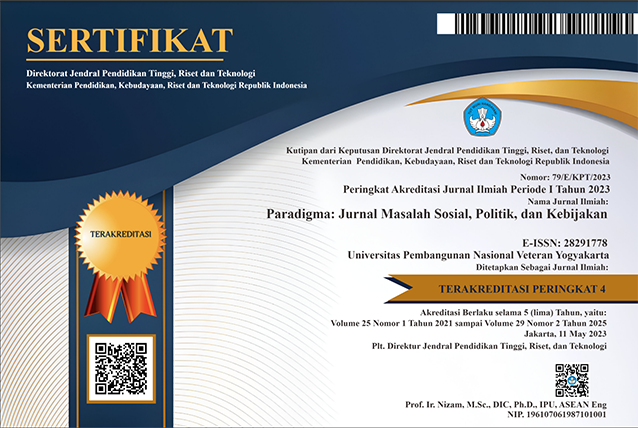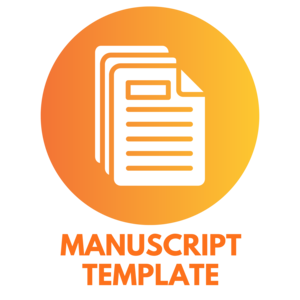Peluang media edukasi populer dalam arus informasi digital: studi analisis isi deskriptif kuantitatif konten video kanal Youtube Nihongo Mantappu.
DOI:
https://doi.org/10.31315/paradigma.v26i2.7432Keywords:
analisis isi kuantitatif, media sosial, vlog youtube, nihongo mantappuAbstract
Kebijaksanaan dan kemampuan literasi kini diperlukan masyarakat untuk mengonsumsi informasi di ranah digital. Media tradisional kini perlahan tergantikan media-media yang ditawarkan di internet. Tetapi tidak semua media dan konten digital layak untuk diserap pengguna. Konten informatif lagi mendidik menjadi sesuatu yang langka di digital saat ini. Kanal Youtube Nihongo Mantappu merupakan salah satu kanal yang tidak hanya mementingkan hiburan, konten informasi dan edukasi kerap disajikan. Penelitian ini bertujuan untuk melihat perkembangan konten-konten yang disediakan oleh kanal Nihongo Mantappu dari tahun 2018 hingga pertengahan 2022 (N; 858). Metode yang digunakan adalah analisis isi deskriptif kuantitatif dengan melabeli setiap video yang frekuensi kemudian didistribusikan. Hasil penelitian menunjukkan adanya ketimpangan dan ketidakkonsistenan jumlah konten yang diunggah setiap semesternya.
Wisdom and literacy skills are essential today for society to consume digital information. Traditional media is slowly being replaced by media offered on the internet. However, not entire digital media and contents are feasible for users to absorb. Informative and educational content is a rarity in today's digital world. The Nihongo Mantappu in Youtube is a channel which is not only concerned with entertainment, information and educational content is often presented. This study aims to see the development of content provided by the Nihongo Mantappu channel from 2018 to mid-2022 (N: 858). The method used is quantitative descriptive content analysis by labeling each video whose frequency is then distributed. The result shows significant gaps and inconsistencies in the number of content uploaded every semester.
References
Azanella, L. A. (2019, February 21). Vlog "Nihongo Mantappu", Cara Jerome Polin Berbagi Ilmu dan Inspirasi dari Jepang Halaman all - Kompas.com. Edukasi Kompas. https://edukasi.kompas.com/read/2019/02/21/13364341/vlog-nihongo-mantappu-cara-jerome-polin-berbagi-ilmu-dan-inspirasi-dari?page=all
Bloom, K., & Johnston, K. M. (2010). Digging into YouTube Videos: Using Media Literacy and Participatory Culture to Promote Cross-Cultural Understanding. Journal of Media Literacy Education, 2(2), 113 - 123.
Humphrey, M. (2011, October 31). YouTube Channels: The Delicate Shift From Social To Mass Media. Forbes. Retrieved July 8, 2022, from https://www.forbes.com/sites/michaelhumphrey/2011/10/31/youtube-channels-the-delicate-shift-from-social-to-mass-media/?sh=4907b4abcd56
Imroatun, I., Widat, F., Fauziddin, M., Farida, S., Maryam, S., & Zulaiha. (2021). Youtube as a Media For Strengthining Character Education in Early Childhood. Journal of Physics: Conference Series, 1779.
Irshad, M. S., Anand, A., & Bisht, M. (2019). Modelling Popularity Dynamics Based on YouTube Viewers and Subscribers. Modelling Popularity Dynamics Based on YouTube Viewers and Subscribers, 4(6), 1508-1521. https://dx.doi.org/10.33889/IJMEMS.2019.4.6-119
Kemp, S. (2022, February 15). Digital 2022: Indonesia — DataReportal – Global Digital Insights. DataReportal. Retrieved July 7, 2022, from https://datareportal.com/reports/digital-2022-indonesia
Kong, G., LaVallee, H., Rams, A., Ramamurthi, D., & Khrisnan-Sarin, S. (2019). Promotion of Vape Tricks on YouTube: Content Analysis. Journal od Medical Internet Research, 21(6). https://doi.org/10.2196/12709
Kusnandar, V. B. (2022, January 20). Indeks Literasi Digital Indonesia Masuk Kategori Sedang pada 2021 | Databoks. Databoks. Retrieved July 7, 2022, from https://databoks.katadata.co.id/datapublish/2022/01/20/indeks-literasi-digital-indonesia-masuk-kategori-sedang-pada-2021
Lacy, S., Riffe, D., Fico, F., & Watson, B. R. (2019). Analyzing Media Messages: Using Quantitative Content Analysis in Research. Routledge.
Moghavvemi, S., Sulaiman, A., Jaafar, N. I., & Kasem, N. (2018). Social media as a complementary learning tool for teaching and learning: The case of youtube. The International Journal of Management Education, 16(1), 37–42. https://doi.org/10.1016/j.ijme.2017.12.001
Neuendorf, K. A. (2017). The Content Analysis Guidebook. SAGE Publications.
Oh, I., & Lee, H.-J. (2013, Winter). Mass Media Technologies and Popular Music Genres: K-pop and YouTube. Korea Journal, 53(4), 34-58. http://doi.org/10.25024/kj.2013.53.4.34
Rahmatika, Yusuf, M., & Agung, L. (2021). The Effectiveness of Youtube as an Online Learning Media, 5(1), 152-158.
Rubiyanto, R. (2022). Strategi SCTV memikat pemirsa dan pengiklan pada tayangan sinetron prime time. ProTVF, 6(1), 123-143. http://dx.doi.org/10.24198/ptvf.v6i1.36931
Seeley, J. S., Wickens, C. M., Vingilis-Jaremko, L., Fleiter, J., Yildimir-Yenier, Z., Grushka, D. H., & Vingilis, E. (2019, May). Street racing, stunt driving and ghost riding YouTube videos: A descriptive content analysis. Transportation Research Part F: Traffic Psychology and Behaviour, 63, 283-294. https://doi.org/10.1016/j.trf.2019.04.012
Setiawan, H., Pawito, & Purwasito, A. (2020). Youtube Social Media Trends Reduce Television Watching Interest. Advances in Social Science, Education and Humanities Research, 510, 125-132.
Social Blade. (2022). Top 100 YouTubers Channels in Indonesia - Socialblade YouTube Stats | YouTube Statistics. Social Blade. Retrieved July 7, 2022, from https://socialblade.com/youtube/top/country/id/mostsubscribed
Srinivasacharlu, A. (2020). Using Youtube in Colleges of Education. Shanlax Interational Journal of Education, 8(2), 21-24. https://doi.org/10.34293/
The Jakarta Post. (2022, January 20). Despite improvements, Indonesia's digital literacy remains low - Economy. The Jakarta Post. https://www.thejakartapost.com/business/2022/01/20/despite-improvements-indonesias-digital-literacy-remains-low.html
Tur-Viñes, V., & González-Río, T.-V. (2021). Is YouTube being used to its full potential? Proposal for an indicator of interactivity for the top YouTuber content in Spanish. Communications, 46(4), 469-491. https://doi.org/10.1515/commun-2019-0127
Yee, L. S., & Hu, T. K. (2022). Implementation of YouTube in Teaching Writing Perception of Malaysian Primary School English Teachers. International Journal of Advanced Research in Education and Society, 4(1), 23-29. https://doi.org/10.55057/ijares.2022.4.1.4
Downloads
Published
How to Cite
Issue
Section
License
The manuscript submitted to Paradigma: Jurnal Masalah Sosial, Politik, dan Kebijakan journals are released under the license of Creative Commons Attribution-Non Commercial- ShareAlike (CC BY SA) if and when the article is accepted for publication.
We declare that:
- This paper has not been published in the same form elsewhere.
- It will not be submitted anywhere else for publication prior to acceptance/rejection by this Journal.
- A copyright permission is obtained for materials published elsewhere and which require this permission for reproduction.
Retained Rights/Terms and Conditions
Authors retain all proprietary rights to the published works, such as (but not limited to) the following rights:
- Copyright and other proprietary rights relating to the article, such as patent rights,
- The right to use the substance of the article in own future works, including lectures and books,
- The right to reproduce the article for own purposes,
- The right to self-archive the article
The right to enter into separate, additional contractual arrangements for the non-exclusive distribution of the article's published version (e.g., post it to an institutional repository or publish it in a book), with an acknowledgment of its initial publication in this journal Paradigma: Jurnal Masalah Sosial, Politik, dan Kebijakan



